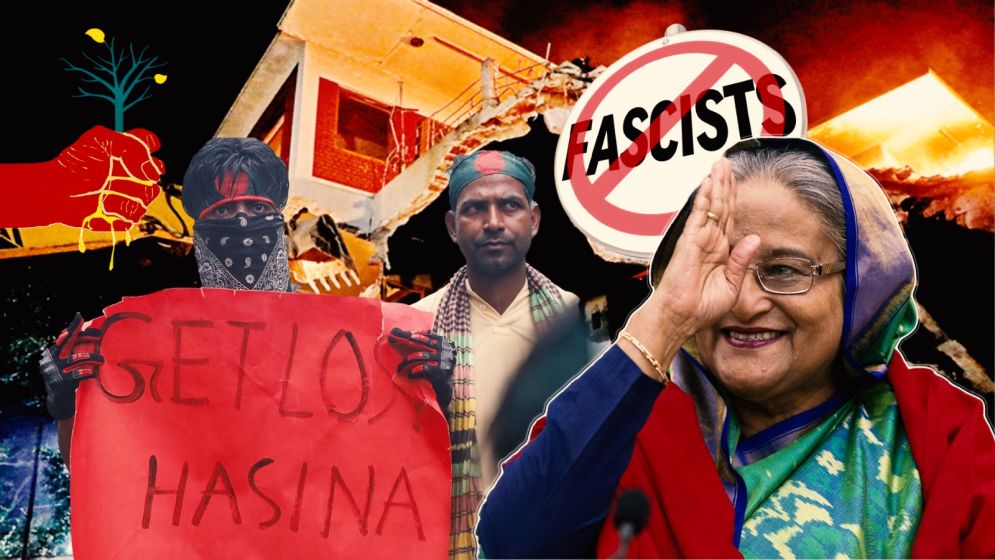Hasina has dug her own grave..now, she is burying the Awami League in it

Let me begin by offering a few clarifications upfront, as a disclaimer.
The demolition of Sheikh Mujibur Rahman’s 32 No. house should not be equated with the destruction of Aynaghar, the notorious prison that once held victims of enforced disappearances during ousted dictator Sheikh Hasina’s regime.
Demolishing Aynaghar would only hinder efforts to investigate Hasina's crimes by eliminating crucial evidence. Furthermore, Aynaghar was never a public symbol of Hasina’s regime; rather, it was a covert tool used to suppress dissent.
Let it be clear: the destruction of 32 No. house in no way threatens the integrity of iconic national landmarks like Shaheed Minar or the National Monument in Savar.
The public’s grievance is not with the Liberation War itself, but with Hasina’s distorted narrative surrounding it.
Is such an act of demolition the harbinger of a new fascism? Absolutely not.
Let’s set the record straight as well: it wasn’t the Interim Government that razed Mujib’s house—which was turned into a museum later on—it was the common people who did so.
Now, I must make one thing unequivocally clear before I present my views: this destruction of a “historically significant” site is the sole responsibility of Sheikh Hasina herself.
To understand why this happened on the night of February 5th at Dhanmondi 32, we must look at the broader context and the sequence of events.
Since her ousting in the wake of the student-led uprising on August 5th of the previous year, Hasina has shown no remorse for the violent acts that led to the deaths of over 1,500 ordinary citizens in just 21 days.
From her undisclosed refuge in India, Hasina made several statements through leaked conversations and, at times, appeared on a live social media broadcast hosted by a blogger with dubious credentials, who had been accused of producing pornographic content.
In these clandestine, often scornful appearances, Hasina, a former Prime Minister, maintained the same arrogant, distorted narrative that ultimately led to her fall from power.
-67a465146adf6.png)
The bulldozer procession and Hasina’s
monologue
Fast forward to the night of February 5th, when a joint declaration from the Awami League and the banned terrorist group Bangladesh Chhatra League announced that Hasina would deliver a speech through a Facebook Live session aimed at students.
This stirred an uproar across Bangladesh.
Student leaders, coordinators of the July uprising, and influential figures such as YouTubers Pinaki Bhattacharya and Elias Hossain, urged the public to converge at Dhanmondi 32.
They described it as the "pilgrimage site of fascism" and called for its demolition.
At 9:00pm, a highly anticipated event called the "Bulldozer Procession" was scheduled to coincide with an online address by Hasina.
The event, broadcasted by the now-banned Chhatra League, the Awami League’s student wing, was poised to draw attention.
However, as the clock struck 8:00pm, hundreds of protesters arrived at the site and began dismantling the 32 No. house with shovels and hammers, an hour ahead of the planned procession.
After a brief standoff, including resistance from the military to allow bulldozers access to the building, demolition finally began around midnight.
Meanwhile, Hasina proceeded with her scheduled speech on Facebook. In her nearly 50-minute monologue, she stuck to the familiar rhetoric that had characterized her public discourse for years.
She started by revisiting the tragic events of August 15, 1975, when her family, including her father, Sheikh Mujibur Rahman, was assassinated. Then, she detailed what she termed as the "so-called developments" under her governments.
As expected, Hasina shifted gears, criticizing the Yunus government with harsh words, painting it as the force behind Bangladesh's destruction since August 5.
Yet, throughout the entire address, she showed no remorse for the massacres that occurred in July and August, instead blaming the very students who had led the uprising for the deaths.
A Facebook user aptly remarked: "I was doubtful about the logic behind the demolition of 32 No. house, but as soon as she [Hasina] opened her mouth, I realized it was absolutely the right thing to do."
So, was demolishing the 32 No. house the right course of action? In light of the current context, the answer is clear: yes.
-67a46544e3c11.png)
The demolition of symbols
Sheikh Hasina’s 15-year rule, cemented by three rigged elections that stripped the people of their fundamental right to vote, gave birth to something far worse than fascism: it fostered a mafia-like state rooted in kleptocracy, functioning like a rentier society.
At the core of Hasina’s regime was cultural fascism, propagated by her and her cronies, who elevated her father, Sheikh Mujibur Rahman, to a god-like status—one who single-handedly liberated Bangladesh from Pakistan.
Hasina’s Awami League, meanwhile, positioned itself as the sole custodian of the "spirit of the Liberation War of 1971," to the point where even war heroes like Martyred President Ziaur Rahman, the second-highest gallantry award recipient, were labeled as “Razakars” (collaborators with the Pakistani army) by her loyalists.
In peddling this distorted narrative, the Awami League tainted the entire history and essence of the 1971 Liberation War. Their version of history alienated a large portion of the population, turning many against anything associated with the liberation struggle.
Over time, Mujib’s deification reached a level where Bangladesh began to mirror the cult-like state control seen in repressive regimes like North Korea, where reverence for the first family was almost akin to religious devotion.
With Hasina’s ousting, the pent-up anger from
years of Mujib worship and the state-driven cult of personality found an
outlet.
Just as fascist regimes of the past maintained their dominance through symbols, the destruction of Mujib’s statues and the dismantling of the symbols of the Sheikh family became an expression of public defiance.
However, this initial wave of anger eventually subsided, and people distanced themselves from further destruction. Yet, as Hasina and the Awami League showed no remorse and continued to cling to the same flawed and convoluted narrative surrounding Mujib and the Liberation War, frustration mounted once more.
On the six-month anniversary of Hasina’s ousting, coinciding with her decision to address the students, the public decided to eradicate the remaining symbols of the Sheikh family’s reign. They did so decisively.
It is crucial to understand that demolishing the physical symbols and ideological remnants of a fascist movement is not just symbolic—it is an essential step in preventing the resurgence of that ideology.
Symbols and ideologies accumulate power over time, and by destroying the structures that represent Awami fascism, the people sent a clear message: they will unite again and again to ensure that this ideology never reemerges.
Meanwhile, Hasina has done a great disservice to her own party by exhibiting the same arrogance and ignorance that led to her downfall. In doing so, she is only ensuring that the political future of the Awami League remains uncertain.
She has already dug her own grave; now, she is burying the Awami League alongside her.
—

